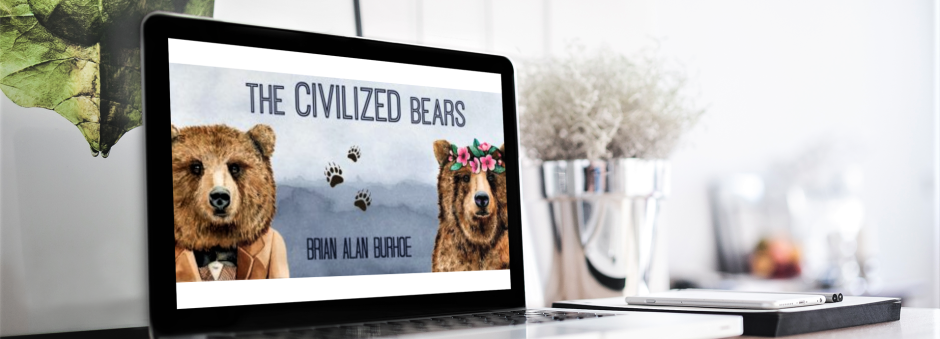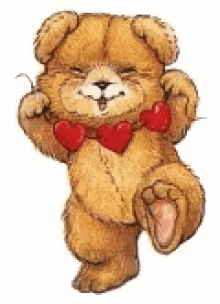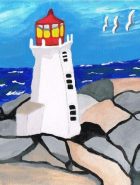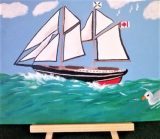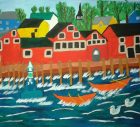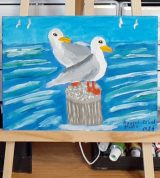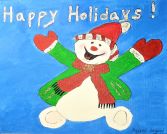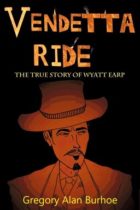My favourite Wildlife artist.
Wildlife artist Charles Livingston Bull.
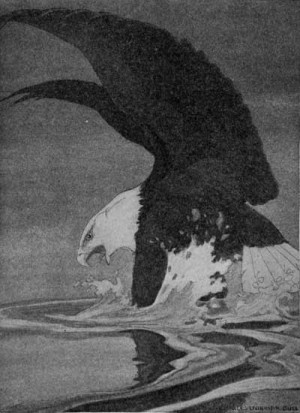
A TRIBUTE TO CHARLES LIVINGSTON BULL, “AMERICA’S PREMIERE WILDLIFE ARTIST!”
“I have no idea how many animal pictures I have made. Thousands of them, probably, and of almost every family of animals.” Charles Livingston Bull
In my case, I first saw the fierce, exhilarating drawings of American wildlife artist Charles Livingston Bull in an old hardcover copy of HAUNTERS OF THE SILENCES. Written by Canadian author Charles G D Roberts.
I’d discovered the animal stories of Roberts in our elementary school readers. And was amazed that such realistic (and often brutal) tales of wild creatures were mixed with the otherwise child-centered pablumesque Dick-Jane-n-Spot stories. Perhaps it was because Roberts wrote a lot about our own New Brunswick forevergreen forests. Or perhaps it was because Sir Charles G D Roberts had once been a worldwide best selling author. Or maybe… [1]
THE KINDRED OF THE WILD
I raided the libraries for more of Roberts’ books. THE KINDRED OF THE WILD. And THE WATCHERS OF THE TRAILS. And in those thrilling books were also fantastic line drawings by that artist named Charles Livingston Bull.
In fact, as I read more books — some from the Libraries, some given to me by local folks who appreciated my love of these old pastoral stories — I came to expect the “Illustrated by Charles Livingston Bull” byline. And thought that those drawings were perfect renditions of the animals and forests that lived right outside our own back door.
I not only saw his artwork in other Roberts’ books like THE HOUSE IN THE WATER and THE RED FOX. But in wilderness-set works by other writers such as Ridgwell Cullum: IN THE BROODING WILD and THE HOUND FROM THE NORTH. NOMADS OF THE NORTH by James Oliver Curwood. And a real personal fave: FLASH THE LEAD DOG by George Marsh.
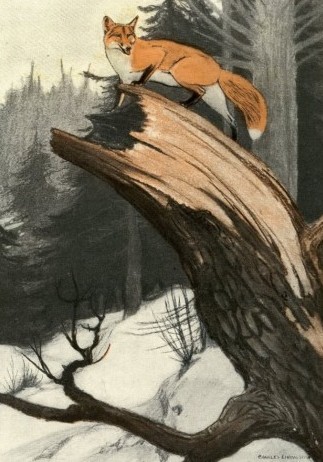
It was a surprise when I discovered wildlife books that were illustrated by different artists. Yes, there were artists in those old books like Arthur Heming, Paul Bransom, Frank E Schoonover, among others. And they were all good at their trade. [2]
But not quite as good as Charles Bull.
There was a kind of vitality in those lines of black ink. Those animals, whether in lazy repose or savage action, lived and breathed right there on the page. And his wilderness settings — with their trees, rocks, bushes — I knew those landscapes. I had walked there.
And I began to wonder about this wildlife artist, “Who is this Bull guy?”
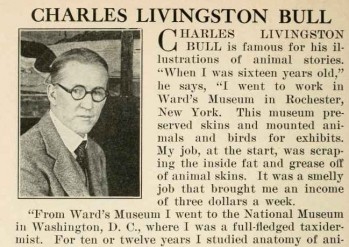
Charles Livingston Bull (1874- 1932) has been remembered as “the premier wildlife artist of his time in America, perhaps the best of his kind in the world. He drew and painted realistic animals, a subject he explored through literature.” [3]
He was born in West Walworth, in New York State, at that time a farming and dairy area.
Charles loved drawing from earliest childhood. In an interview, he said, “My mother says that from the time I was four years old, I could draw any animal I saw, and draw it fairly well, too.” [4]
But when his father heard of his artistic endeavors, Charles was informed that he should get a real job. His father apprenticed him to a taxidermist. Although the young artist was still able to take free evening drawing classes at the Rochester Athenaeum & Mechanic’s Institute.
“When I was sixteen years old, I went to work in Ward’s Museum in Rochester, New York.” explained Charles in another, rare interview. [5]
“This museum preserved skins and mounted animals and birds for exhibits. My job, at the start, was scraping the inside fat and grease off of animal skins. It was a smelly job that brought me an income of three dollars a week.
“From Ward’s Museum I went to the National Museum in Washington, D. C, where I was a full-fledged taxidermist. For ten or twelve years I studied anatomy of animals and birds, and then I was ready to make some pictures.”
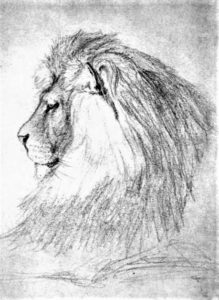 Ready to pursue his wildlife artist dream, Charles quit his National Museum job and moved to New York City.
Ready to pursue his wildlife artist dream, Charles quit his National Museum job and moved to New York City.
For many years he would live right across the street from the Bronx Zoological Gardens, where he went almost daily to observe and draw the animals.
At that time, the Bronx Zoo was designed around a circular sea lion pool. With almost a thousand mammals, birds, reptiles and fishes featured in a number of pavilions. As well as the usual zoo inmates like lions, tigers, monkeys and polar bears, the Zoo also featured captured bison and snow leopards. And Charles drew them all.
The plight of the caged animals bothered him.
Later, in reference to some circus posters he had produced for the Barnum & Bailey Circus, Charles said, “Never really a circus lover. These posters though make me happy. But I have given lots of thought as to how unhappy the animals may be. I guess PT Barnum wasn’t thinking of the animals when he said, ‘The noblest art is that of making others happy.'”
He began to sell artwork to local magazines. And to get some early commissions. One was for the 1901 Pan-American Exhibition in Buffalo.
And then…
Wildlife Artist meets Animal Story Writer
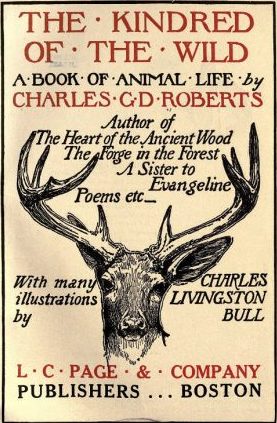 Maybe it was the excitement of the new century. But, on hearing that Charles G D Roberts was staying in New York City for a few weeks, the normally shy artist put together a portfolio of his best work and set out to meet the popular Canadian wildlife writer. He introduced himself at the door by saying that he wanted to be Roberts’ illustrator.
Maybe it was the excitement of the new century. But, on hearing that Charles G D Roberts was staying in New York City for a few weeks, the normally shy artist put together a portfolio of his best work and set out to meet the popular Canadian wildlife writer. He introduced himself at the door by saying that he wanted to be Roberts’ illustrator.
Roberts was impressed by the 27-year old’s artwork. And took him personally to meet his American editors. He told them that Bull was the perfect man to illustrate his new book in production, THE KINDRED OF THE WILD: A Book of Animal Life.
Released in 1902, KINDRED OF THE WILD quickly became an acclaimed best seller, showcasing a writer at the height of his power — and a young artist of great skill…
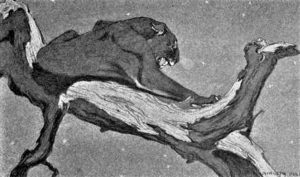
“He dug his claws deeper into the bark, and bared his fangs…”
Magazines & Books
And Bull’s work was soon appearing in publications such as Outing Magazine, Boy’s Life, The Country Gentleman, Collier’s, Country Life in America, The Saturday Evening Post and Sunday Magazine.
When he began to get commissions to illustrate the books of other best selling authors like Rudyard Kipling, Jack London (first editions of THE CALL OF THE WILD and WHITE FANG) and Frank Baum, his career blossomed.
Charles Bull began to travel further afield in search of wildlife studies.
Having a keen interest in birds, from helping with early bird-banding plans to supporting projects to save the endangered Bald Eagle, the wildlife artist studied every bird with a noticeable enthusiasm.
He was able to take annual trips to Canada, where he saw animals in the wild, capturing their drama and the wilderness where they lived. When on these trips, he would stay still for hours with his binoculars, watching a bird on its solitary perch, or a mammal quietly going about its routines of seeking food or water.
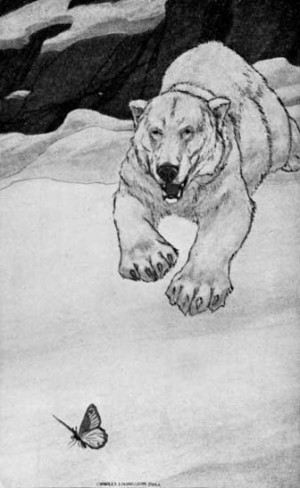
With his sketches, he would return to his studio…
“Sometimes when I take a story to illustrate, I make an outline of an animal, then go to a zoo and sit by the cage of that lion, tiger or whatever it is. I watch him closely as he walks, leaps, crouches, and from his positions I correct my outline and then carry it home to be filled in.”
“My working hours are probably the craziest in the world for I begin at four in the afternoon and work until two the next morning.”
And, in a time of richly illustrated magazines and books, he gained a popular following among readers, writers and fellow artists. His wildlife art evolved into something uniquely vital and dramatic. [6]
As art historian Priscilla Anne Lowry has written, Bull was inspired by “the traditions of Japanese woodblock prints and the English Aesthetic; the Arts and Crafts and Art Nouveau. And particularly the bold yet sinuous drawings of Aubrey Beardsley, Bull established an attractive style of linear and tonal compositions.” [7]
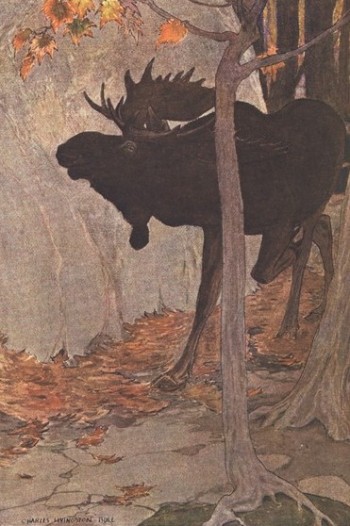
In 1910, Charles Bull and his wife Fanny Elizabeth moved to Oradell, New Jersey.
There he established a home with a new art studio on a property of field and trees, filling it with animals, both domestic and wild. His menagerie included ducks, geese, turkeys, peacocks, sheep, and assorted species of fish.
For a while, he even had a herd of deer there. 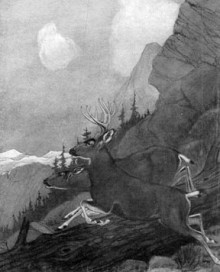
And did some of his best work as America’s most beloved wildlife artist. Not one for many interviews, and avoiding public events, he gained the rep of being a “reclusive artist.” While not as shy or retiring as fellow wildlife artist German-born J C Leyendecker, Charles did prefer the private life of a quiet, peaceful country gentleman.
A neighbour referred to him as “a quiet, totally abstracted, very pleasant man who never said anything and who lived for his work and his animals.”
Later published artwork included magazine illustrations for popular authors like Edgar Rice Burroughs (TARZAN THE UNTAMED, Red Book Magazine, March to August, 1919). As well as dramatic covers and illustrations for hardcover books such as THE RED FEATHERS and FLYING PLOVER both by Theodore Goodridge Roberts (Charles G D’s brother). OLD CROW AND HIS FRIENDS by Katharine B Judson. FLASH THE LEAD DOG and THE HEART OF THE KING-DOG both by George Marsh. SILVERSHEENE KING OF LEAD DOGS by Clarence Hawks. ROWDY AN ALASKAN DOG STORY by Robert Joseph Driven. WOOD-FOLK COMEDIES by William J Long. And LORDS OF THE WILD by Samuel Scoville.
Charles is loved and respected in Canada.
The largest permanent collection of his work is at the Glenbow Museum in Calgary, Alberta. It includes original charcoal and ink drawings, posters, magazine and book illustrations, and some illustrated books.
He’s still remembered and revered. Especially by those of us who first saw his wildlife artwork in their original format: treasured old outdoor magazines and faded hardcover books. [8]
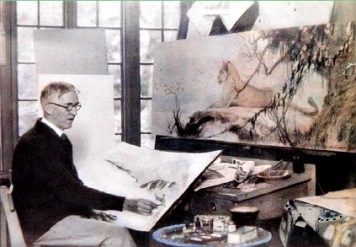
Wildlife artist Charles Livingston Bull in his Oradell, New Jersey art studio.
As his friend and fellow naturalist Beecher S Bowdish wrote, “Charles much preferred watching the wild creatures alive than dead, so he didn’t often use a gun. He was always looking for the beauty of the beautiful and I have heard many say that it was this trait that made him so delightful a companion in the field. He was gentleness and kindness itself and the most unselfish of men…”
Oh yes, Charles Livingston Bull is still remembered.
“Live Free, Mon Ami!” – Brian Alan Burhoe
To see more of Charles Livingston Bull’s artwork, go to “The Bear That Thought He Was A Dog” A Complete Short Story by Sir Charles G D Roberts
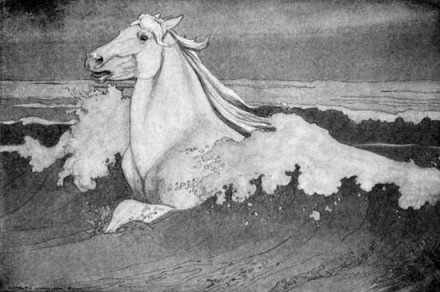
NOTE: With the exception of the early lion sketch, all of Charles Bull’s artwork on this page illustrates writings of Sir Charles G D Roberts.
[1] “Or perhaps it was because Sir Charles G D Roberts had once been a worldwide best selling author. Or maybe…” Or maybe because all Animal Stories are filed away on the Children’s Literature shelves. Whether the gentle tales of Beatrice Potter or the bleak, violent stories of Jack London.
[2] As I later came to love the cover art and illustrations of artists like Emsh (Ed Emshwiller), Jack Gaughan, Roy G Krenkel and Frank Frazetta.
[3] www.askart.com/AskART/artists/biography.aspx?searchtype=BIO&artist=3282
[4] Leroy Vincent, Boy’s Life, Dec 1928, page 38
[5] BRIEF BIOGRAPHIES OF SOME WELL-KNOWN AUTHORS AND ILLUSTRATORS, by Samuel G Goodrich, page 19. Published by Penn Publishing Company, Philadelphia, 1929. Further Reading: SIR CHARLES GOD DAMN: The Life of Sir Charles G D Roberts by John Coldwell Adams, University of Toronto Press, 1986.
[6] To me, as a boy, only Canadian Hal Foster matched Bull in inspired artwork. I remember a scene in a Prince Valiant Weekend comic strip (in a neighbour’s scrapbook collection of pages older than I was) when Val was travelling on a Viking longboat down a forest-edged river in what would someday be Canada. So real were Foster’s drawings that I swore I could smell the firwood forest and hear the creak of the longboat’s rigging and timbers. It put me there.
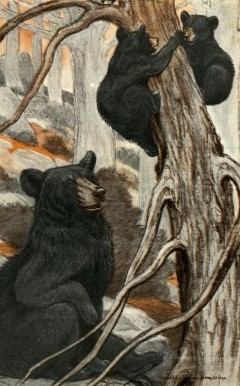 [7] “CL Bull’s monochromatic style of rendering the animal in the natural setting with charcoal and ink on paper — the perfect medium for reproduction as a halftone for book illustration — all but established illustrated wildlife writing and the illustrated animal story as the most popular genre of the early twentieth century. CL Bull was the chosen animal illustrator for many writers.” – Priscilla Anne Lowry, http://www.lowryjames.com
[7] “CL Bull’s monochromatic style of rendering the animal in the natural setting with charcoal and ink on paper — the perfect medium for reproduction as a halftone for book illustration — all but established illustrated wildlife writing and the illustrated animal story as the most popular genre of the early twentieth century. CL Bull was the chosen animal illustrator for many writers.” – Priscilla Anne Lowry, http://www.lowryjames.com
[8] In 2010, the National Museum of Wildlife Art created the Bull-Bransom Award in honour of Charles Livingston Bull and Paul Bransom, “who were among the first and finest American artist-illustrators to specialize in wildlife subjects. The Bull-Bransom Award is given annually to recognize excellence in the field of children’s book illustration with a focus on nature and wildlife.” To Learn more about this Wildlife Artist award, you can visit Wildlife Art – Bull-Bransom Award.
